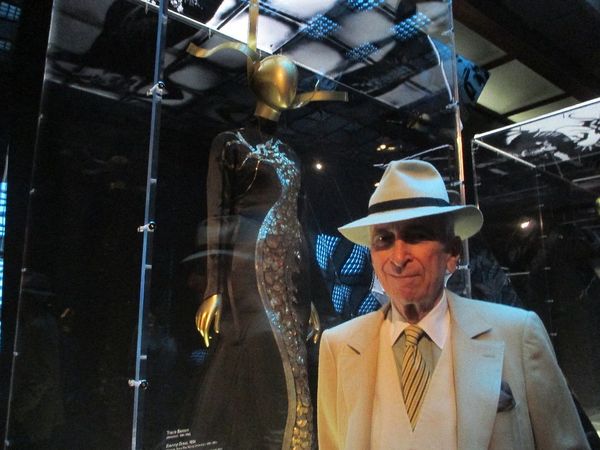 |
| Gay Talese in China: Through The Looking Glass at The Metropolitan Museum of Art in front of Anna May Wong's Travis Banton dress from Alexander Hall's Limehouse Blues. Photo: Anne-Katrin Titze |
The Grandmaster director Wong Kar Wai, as artistic director of China: Through The Looking Glass, magically merges film with fashion and the museum's collection. Michelangelo Antonioni's Chung Kuo - Cina, Jiang Wen's In the Heat Of The Sun, Yonggang Wu's The Goddess, Zhang Yimou's Hero, Ang Lee's Lust, Caution, Hou Hsiao-Hsien's Flowers Of Shanghai, D.W. Griffith's Broken Blossoms, Sergio Leone's Once Upon A Time In America, Richard Quine's The World Of Suzy Wong, Bernardo Bertolucci's The Last Emperor, Vincente Minnelli's Ziegfeld Follies and Wong's The Hand From Eros, are among the clips selected that tie in beautiful layers of meaning.
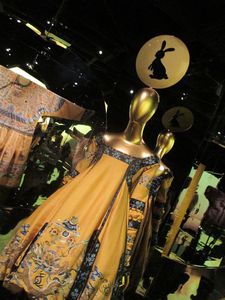 |
| John Galliano for House of Dior Haute Couture yellow silk jacquard - rabbit in the moon Photo: Anne-Katrin Titze |
"Let's pretend the glass has got all soft like gauze, so that we can get through," says Lewis Carroll's Alice, and like her, you lose control as the enchantment kicks in. "Why, it's turning into a sort of mist now, I declare."
And when you have Gay Talese as your traveling companion to the reverse side of the mirror, another whole world of stories opens up. Gay's entrance to China turned out to be through women's feet. A soccer player losing the World Cup, foot binding, the first written version of Cinderella, bridal chairs and pedestals were what we talked about while strolling through the first half of the exhibit.
Billie Holiday's rendition of These Foolish Things, the lyrics inspired by Anna May Wong, welcomes you to the permanent Chinese collection of the Met transformed into an imaginary wonderland of dialogue between Western fashions and Eastern arts, where Yves Saint Laurent's Opium drawings meet a gourd-shaped vase from the 18th century. No other fashion exhibit has made me contemplate the fabric of time quite like this. Centuries and continents separate some of the garments you thought were twins.
Guo Pei's blue and white evening gown, Rodarte porcelain silk crepe, Mainbocher jacquard, a cheongsam from the 1930's and one by Marc Jacobs for Louis Vuitton, a satin robe from 18th century China, Dries Van Noten dragons, a 1920's qipao, and Margiela's metal beads mingle so naturally that it is impossible not to surrender to their allure. Karl Lagerfeld Chanel Haute Couture, the House of Dior and John Galliano, Giorgio Armani, Alexander McQueen, Isabel Toledo, Valentino, Jean Paul Gaultier, and Ralph Lauren imagine "chinoiserie" in their own way from the Anna Wintour Costume Center on up through the Egyptians to the Chinese galleries on the second floor.
 |
| Red silk satin embroidered shoe with Callot Soeurs La Fille de Roi de Chine Flacon, 1923 Photo: Anne-Katrin Titze |
"Within the conventions and trajectory of chinoiserie, China is a site on which historically changing fears and desires are projected. As a style, it belongs to the broader tradition and practice of Orientalism, which since the publication of Edward Said's seminal treatise on the subject in 1978 has taken on negative connotations of Western supremacy and segregation." China: Through The Looking Glass Costume Institute curator Andrew Bolton posits at the start of the exhibit.
The first image conjured up for me is not of China but the inside of St. Paul's Chapel at Columbia University In 2004 when Edward Said was being remembered by Vanessa Redgrave, Nadine Gordimer and Daniel Barenboim with a Schubert recital.
Anne-Katrin Titze: I was at Edward Said's memorial at Columbia.
Gay Talese: I was there. Daniel Barenboim was playing the piano. I loved him. He was quite a man. But let's stay on the subject of China. What I find overridingly amazing about this event here is that at my time in life, at my age, I'm 83, I remember as a child World War II. I remember the struggle of the Chinese people, particularly as a people who had a hopeless, hapless circumstance. Invaded by Japan, not really the victors or the losers of World War II, but almost a splinter group because the nation broke up in a civil war where our favourite nationalist leader Chiang Kai-shek and his wife were representing China. But they didn't. They were misrepresenting China.
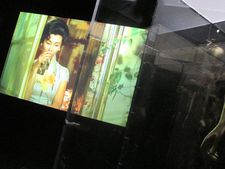 |
| Maggie Cheung in Wong Kar Wai's timeless In The Mood For Love Photo: Anne-Katrin Titze |
As a boy in World War II, reading the newspapers, watching the news, in the movies and on the radio, China was a nether land. China was not identified as anything but struggle. The people struggling who came and built our railroads in the 1800s, downtrodden, hopeless. China had a great culture but that wasn't at all in the forefront in our consciousness during the 1940s.
AKT: When did you first travel to China?
GT: 1998 I made my first trip to China and in 1999 I went and stayed five months. And I went back in 2000, 2001, 2003, 2004 and stayed months at a time. Still Mao was alive in the fashion. You still saw old China in the revolutionary garb but you also saw the new people, the young people in modern garb, having their first introduction to Western fashion.
The reason I went to China was because of a woman. The reason I went to China as a writer was to write about that woman. In 1998, I happened to watch television. There was a match between the women of China, soccer players, and the women of the United States in the World Cup that took place in the Rose Bowl in Pasadena, California. In the audience was President Bill Clinton. The game went on scoreless until the final overtime.
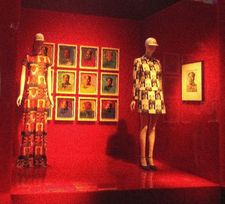 |
| Andy Warhol meets Mao - Vivienne Tam outfits: "Then he becomes a cult figure. He becomes almost an Andy Warhol figure." Photo: Anne-Katrin Titze |
Then they had what they call penalty kicks. All the players made the kicks - one person missed. That's how China lost. This happened to be two months after the bombing of the Chinese Embassy in Belgrade… This little girl I saw on television with a terrible look of horror on her face, I thought she has to fly back to China from California with her teammates and face what? This was the year of the 50th anniversary of the Mao success. I thought, this woman, I must meet her. Thus my interest in China was a woman.
AKT: A soccer player.
GT: The reason I thought it was important, because a soccer player uses obviously their feet. I thought the soccer player's mother was probably a child of the Cultural Revolution. Probably on a farm feeding the pigs. Her grandmother might have been a woman who had bound feet. I was thinking, if I can get to that woman, to her mother and her grandmother, I will get a history of China through feet, women's feet.
AKT: This exhibition does not take us to China but to a China through the Looking Glass. A China of surfaces and our imagination.
GT: Professor Said in this interesting Through The Looking Glass introduction mentions how our senses of an other, of the Asians or Chinese, are so ambiguously defined, are not really specific, except in a negative way, in a way Mao was negative. Then he becomes a cult figure. He becomes almost an Andy Warhol figure.
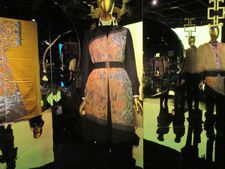 |
| Dries Van Noten dragon ensemble Photo: Anne-Katrin Titze |
AKT: The exhibition, I believe, is so interesting because it takes Edward Said's study, Orientalism, as a starting point. It takes a closer look at the fabric of what he called "subordinated otherness". And then takes a closer look at the misperceptions, at the fantasies about China through fashion and film that are romanticised and often not politically correct at all. The outcome is a fresh and daring perspective.
We stroll into the Carl and Iris Barrel Apfel Gallery and look at clips from The Goddess (1934), Lust, Caution (2007), The World Of Suzy Wong (1960), Wong Kar Wai's Eros ("The Hand" segment, 2004) and In the Mood For Love (2000).
Nat King Cole is crooning in the air, while Maggie Cheung and Tony Leung look fabulous and in the mood for love.
AKT: Look at the fabric and cut of these dresses!
GT: This is post-Mao. What you see here is the western influence on Asian fashion, even though they maintain through the patterns much of what you think of as the art of China. The women are slender, they are small boned and they can really wear beautifully cut clothes. They are not voluptuous to the point where they distort shape. Look at that figure!
 |
| Ralph Lauren jacket and a Chinese theatrical costume from 1736 Photo: Anne-Katrin Titze |
AKT: Wong Kar Wai, who directed In the Mood for Love, is the Artistic Director of the exhibit. You get the sense as though you enter into one of his movies. You start out thinking about China and then get caught up into this very intriguing fantasy world that is merging and blurry and not politics.
A clip from The Goddess comes on.
AKT: This would be the time period of the mother of the soccer player?
GT: She would have been a child. The mother was about my age, born in the 1930s. She was in her twenties when the Cultural Revolution began.
AKT: This is from Lust, Caution, directed by Ang Lee [taking place in the Hong Kong of 1938 and Shanghai in 1942] and here is William Holden in The World Of Suzie Wong with Nancy Kwan.
We stroll on and look at the juxtaposition of a Chinese robe from 1821 and a French evening coat from 1925.
GT: What are we looking at?
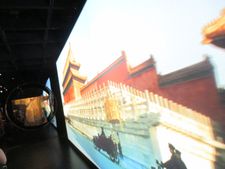 |
| Bernardo Bertolucci's The Last Emperor projected and reflected Photo: Anne-Katrin Titze |
AKT: This is a jacket by Ralph Lauren from 2011 and a Chinese theatrical costume from 1736. Behind us are scenes from Bernardo Bertolucci's The Last Emperor.
GT: This child lived a long time.
AKT: The Chinese title of the exhibition is "Moon In The Water." Did you ever come across this description for elusive perfection? You said these dresses floating on the water made you think of bridal chairs?
GT: The idea of a bridal chair carrying all that, still in the 1930s. The grandmother of the soccer player, she told me about her girlhood. She had a bridal chair when she was married. They didn't lower themselves. They were comparable to royalty. There is so much elitism in Chinese style history. The forbidden palaces, so remote from ordinary life. All the walls. The city of Beijing used to be a city of walls. Mao destroyed all those walls.
AKT: The foot binding tradition was such an incredibly cruel practice.
GT: Well, but it's like putting people on a pedestal.
AKT: You can't move on a pedestal, either.
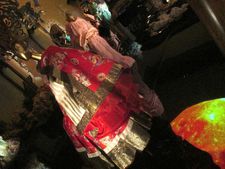 |
| John Galliano for House of Dior Haute Couture - Moon In The Water Photo: Anne-Katrin Titze |
GT: I know, but you're served. You don't lift a finger. I mean, the idea of those Mandarin fingernails - what they connote in terms of status. You don't do anything, you don't break a nail. Other people with their hands and body serve and carry you.
AKT: It isn't surprising that the first written version that we know of the tale Cinderella, including a shoe, is from 9th century China.
GT: I didn't make that connection. But that's so extraordinary about the soccer players, they all wear those shoes with spikes. And they ran and they traveled and they were unsupervised, relatively. No bridal chair for those people. It's amazing, there's no part of the world that has had its image changed, I think, more than China.
In part 2, Dior and calligraphy, tailoring, the House of Chanel, Myrna Loy, Anna May Wong, Callot Soers, Coco Chanel in Jean Renoir's The Rules Of The Game, Opium, Edward G. Robinson in Little Caesar, Cesar Romero, the elegance of Ahmet Ertegun, Tyrone Power, Fred Astaire and the Duke of Windsor, meeting Gene Kelly, Marcello Mastroianni and Federico Fellini.
China: Through the Looking Glass is on view through August 16, 2015 at The Metropolitan Museum of Art in New York City.





















